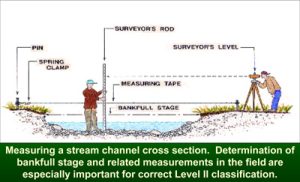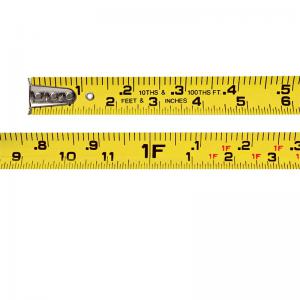1.1 Decimal Feet
Applications
Rosgen stream classification helps us characterize stream processes and the aquatic habitats they create. As part of stream classification efforts, we often walk alongside or wade a stream and measure riffles, runs, and pools. This work usually involves reading a tape measure, calling out measurements while your partner records them, and adding measurements up - all over the noisy background of wind and moving water.
Try adding up the following numbers in your head: 3 ft 4 in, 12 ft 3 in, 16 ft 9 in
Now, try adding up these numbers: 3.3 ft, 12.25 ft, 16.75 ft
Which is easier? Which numbers are easier to shout out and write down?

The U.S. customary system of measurement developed from the system used in England centuries ago.Want some Wikipedia rabbit holes? Visit https://en.wikipedia.org/wiki/United_States_customary_units and https://en.wikipedia.org/wiki/English_units.
If we are working in the metric system, it's easy to record length measurements as decimals.

On a meter tape, if we measure out to 5 meters, 3 centimeters, and 2 millimeters - we record this measurement as 5.32 meters. If we measure out to 12 meters, 8 centimeters, and 3 millimeters - we record this measurement as 12.83 meters. How's that for easy?!?
Why not metric?
If meter tapes are so easy to read, record, and calculate from - why do we use anything else? Well - change is hard, right? Industries with machinery calibrated to old English measurements, signs, and instruction manuals would need to be updated. So far, the lobbies against this expensive change have won out, and the United States remains out of step with the standardized metric system used by most other countries. In general, scientific publications and work in the science field use metric measurements. You may also notice that the United States Geological Survey (USGS) is transitioning to the metric system.

In the meantime...
Decimal feet are a compromise that provide some of the convenience of metric measurements while maintaining our familiar English units. In decimal feet a tape is divided into feet, and tenths of a foot (rather than into feet and inches).

On the tape shown above a mark at 1 foot, one tenth of a foot and three more lines to the right is recorded as 1.13 ft. A mark at 2 feet, four tenths of a foot and eight more lines to the right is recorded as 2.48 ft.
Making the conversion - feet and inches to decimal feet
Let's say we have building plans in feet and inches and we are measuring in decimal feet. Here's the process to convert from feet and inches to decimal feet.
Feet and Inches to Decimal Feet
- Pull the inches off.
- Divide the inches by 12 to get decimal feet.
- Add this to the feet.
- Round as needed.
Examples: Feet and inches to decimal feet
Making the conversion - decimal feet to feet and inches
Let's say we've made measurements in decimal feet and need to convert to feet and inches for reporting purposes.
Decimal Feet to Feet and Inches
- Pull the whole feet off.
- Take the decimal and multiply by 12 to get inches.
- If you have a decimal after your inches, you'll either round to eighths, sixteenths, or thirty-seconds.
- To round to eighths, take the decimal, multiply it by 8, round to the nearest whole number, and use that as the numerator over an 8.
Examples: Decimal feet to feet and inches
Problem Set 1.1
-
Convert 1.5 feet to feet, inches, and round to the nearest 8th of an inch.
-
Convert 2.05 feet to feet, inches, and round to the nearest 8th of an inch.
-
Convert 14.26 feet to feet, inches, and round to the nearest 8th of an inch.
-
Convert 3.47 feet to feet, inches, and round to the nearest 16th of an inch.
-
Convert 1.62 feet to feet, inches, and round to the nearest 16th of an inch.
-
Convert 4 feet 8 and 7/8 of an inch to decimal feet. Round to the hundredths place.
-
Convert 13 feet 2 and 5/8 of an inch to decimal feet. Round to the hundredths place.
-
Convert 10 feet 3 and 3/8 of an inch to decimal feet. Round to the hundredths place.
-
Convert 2 feet 5 and 3/4 of an inch to decimal feet. Round to the hundredths place.

